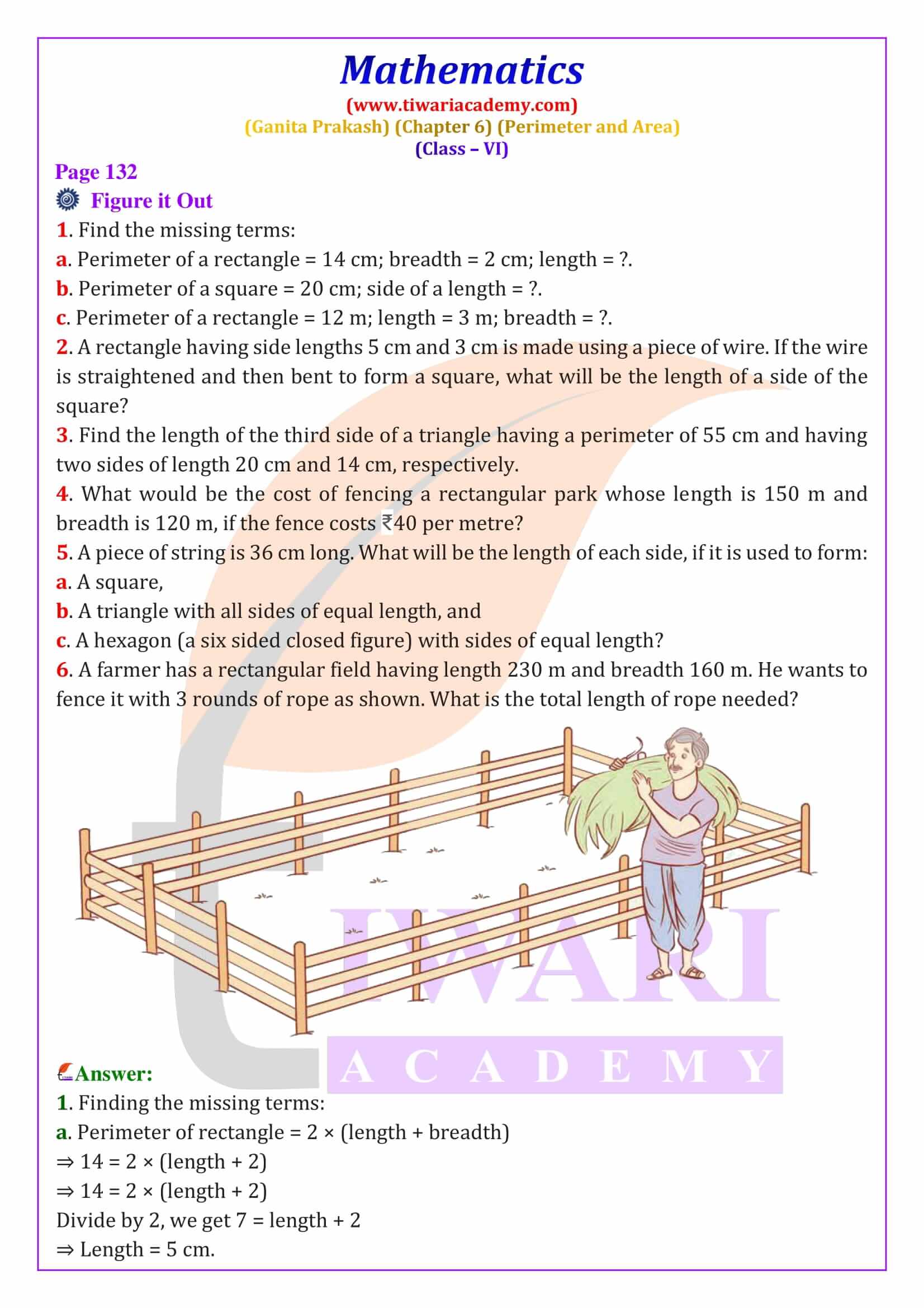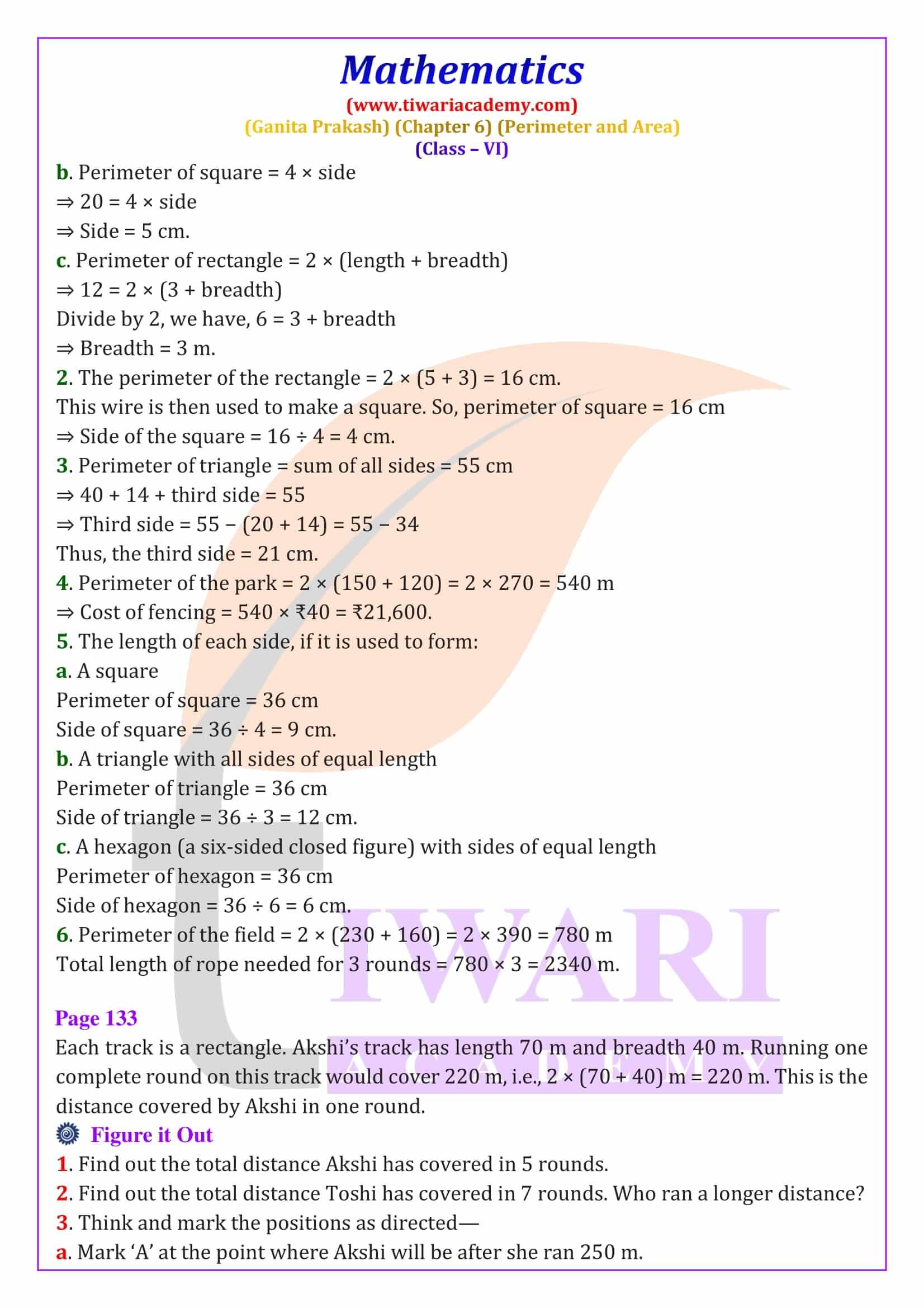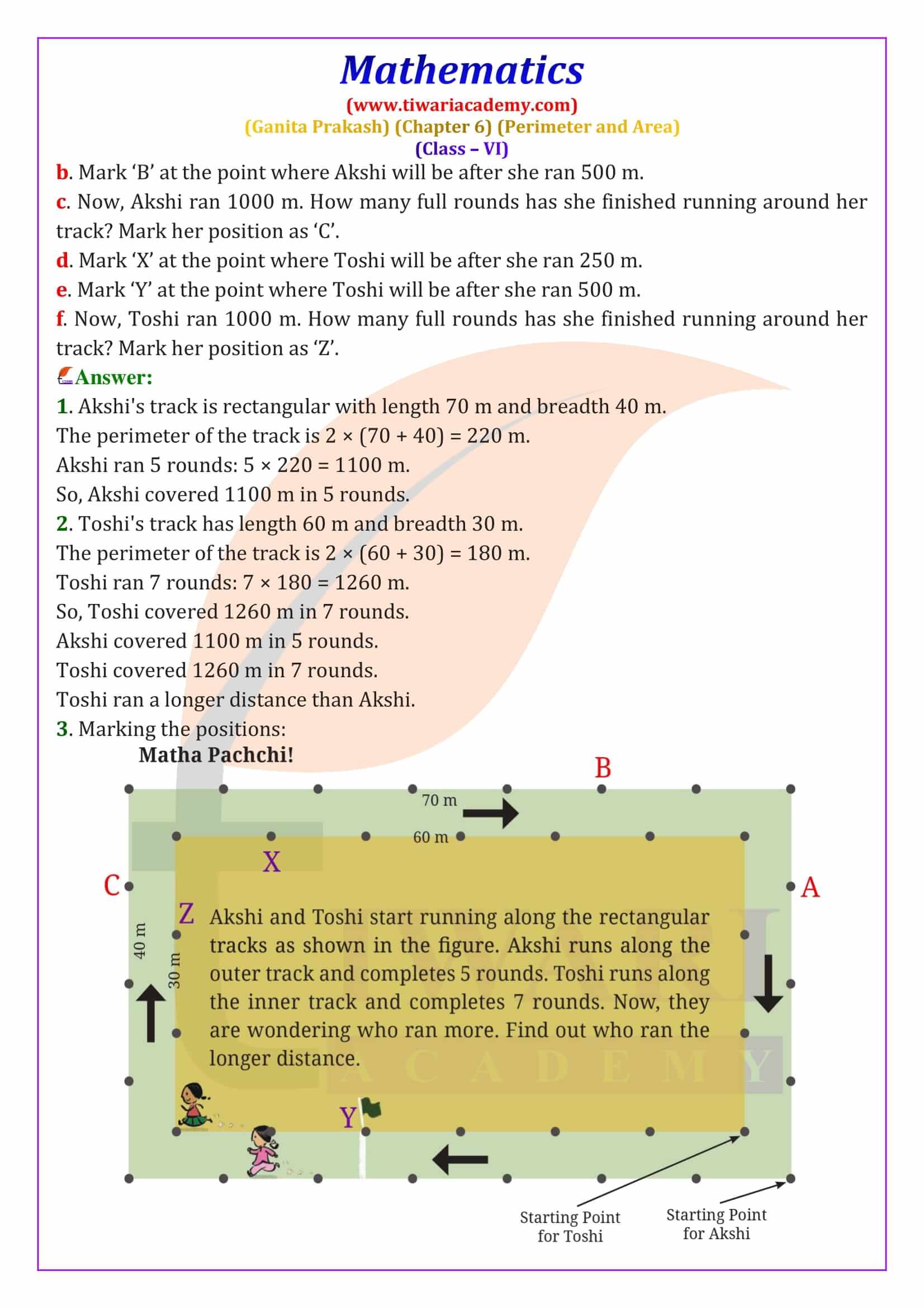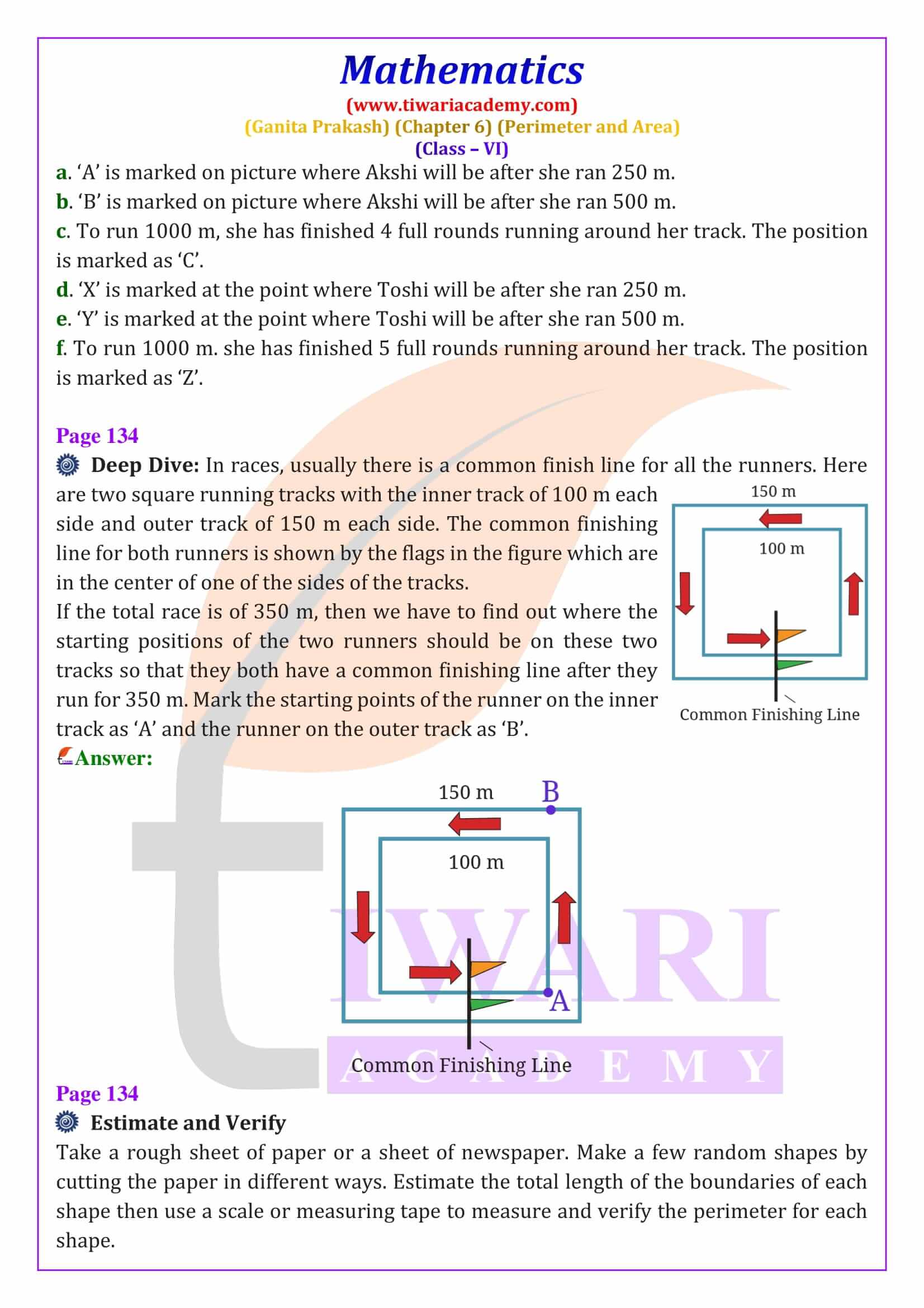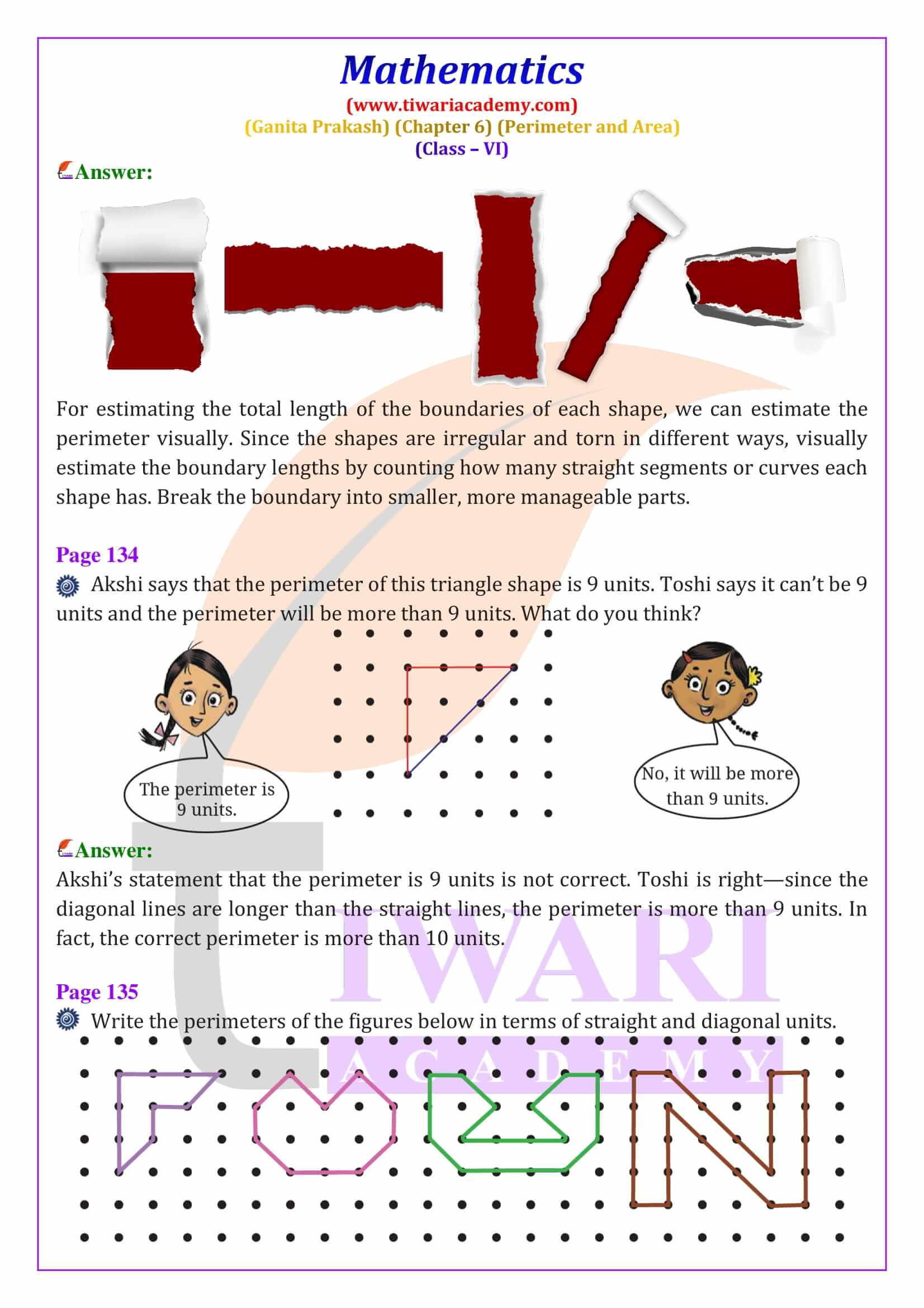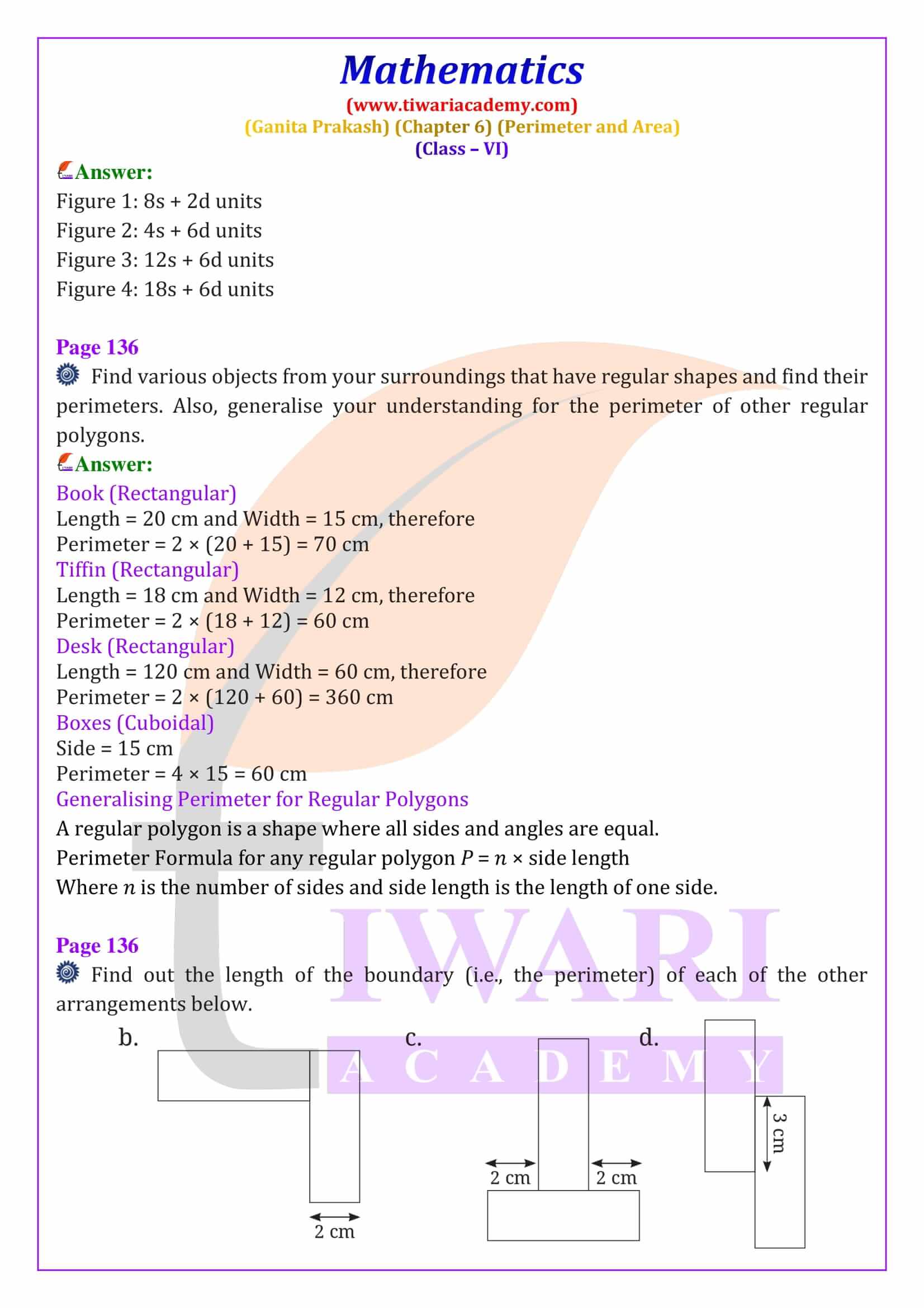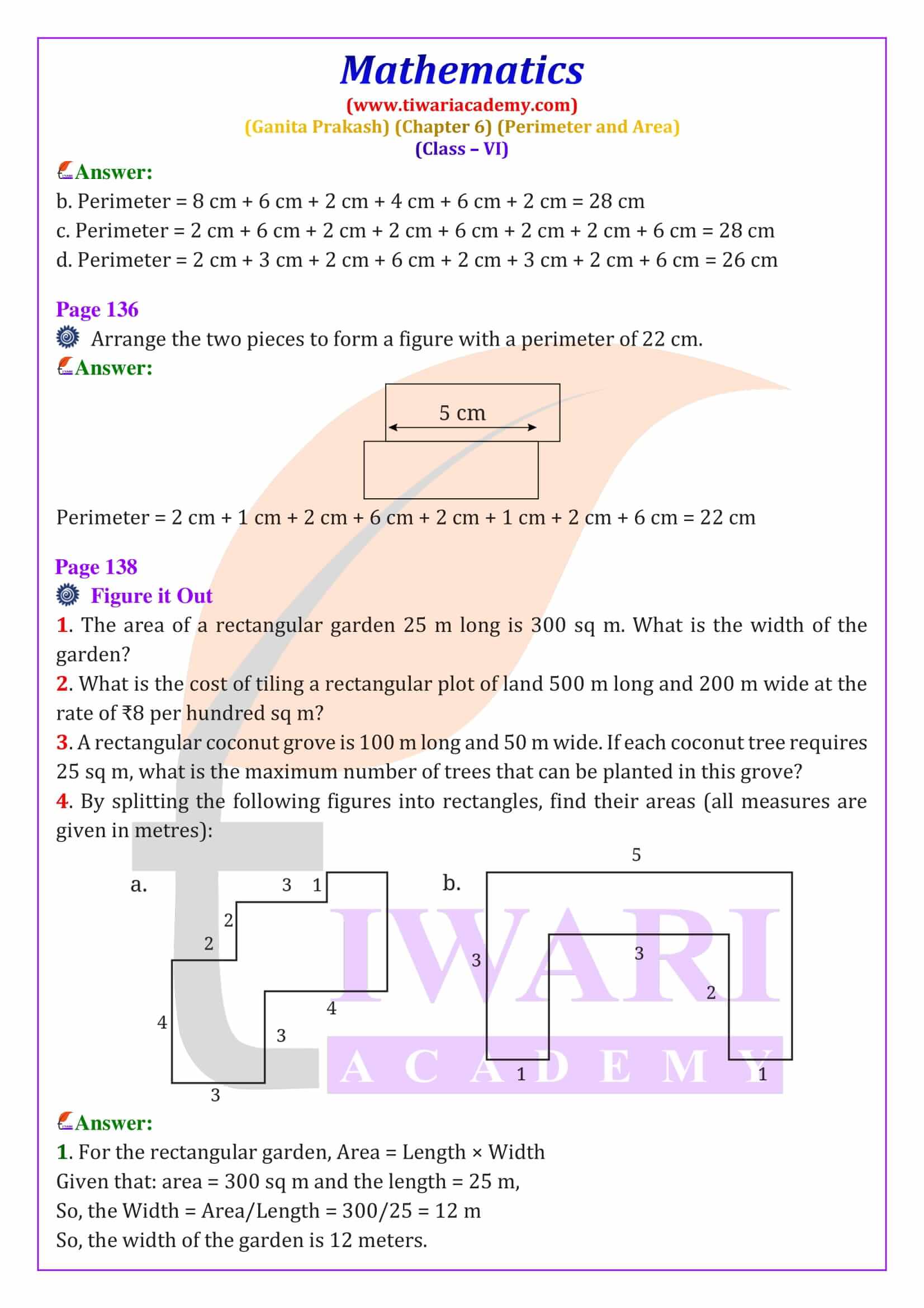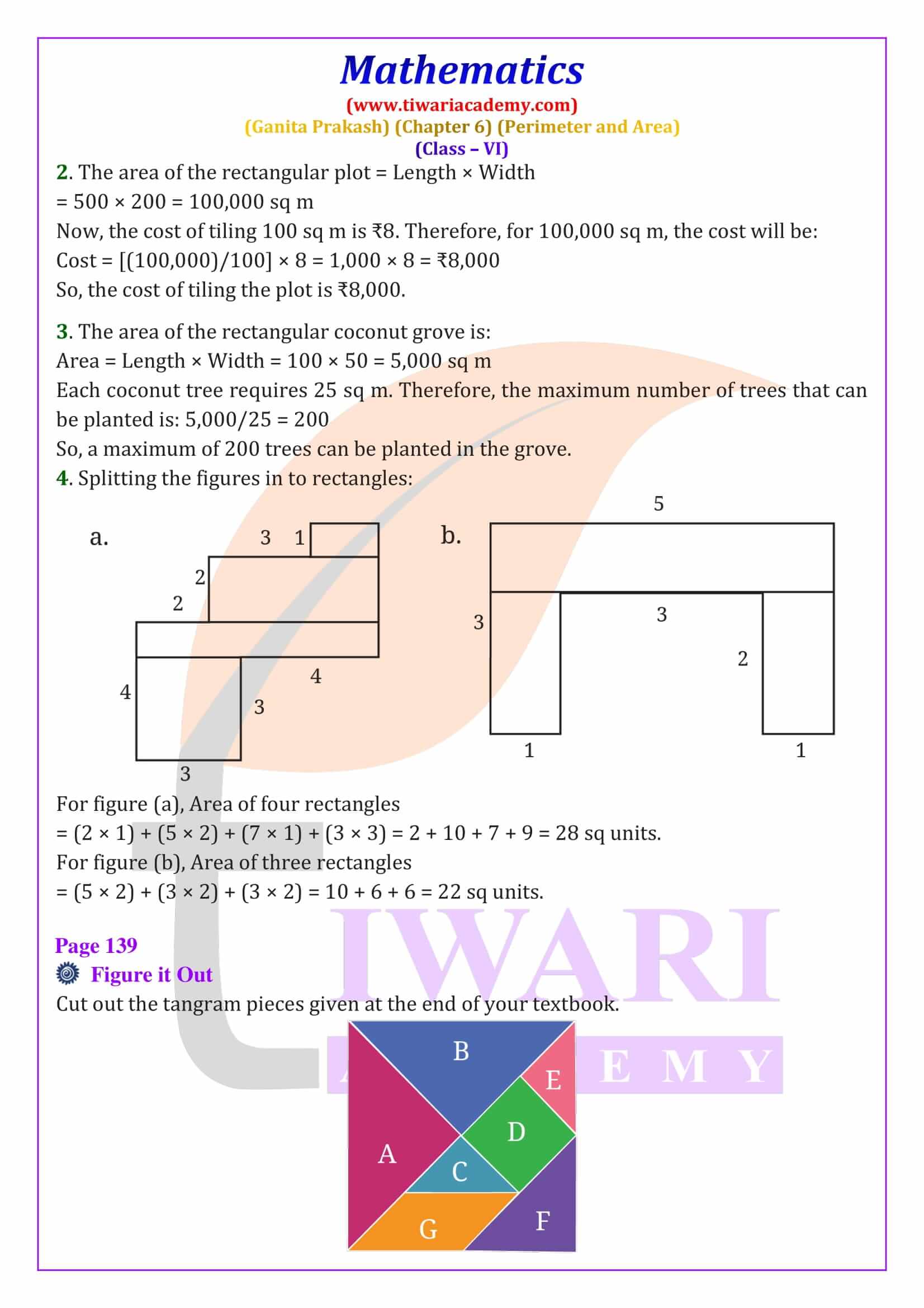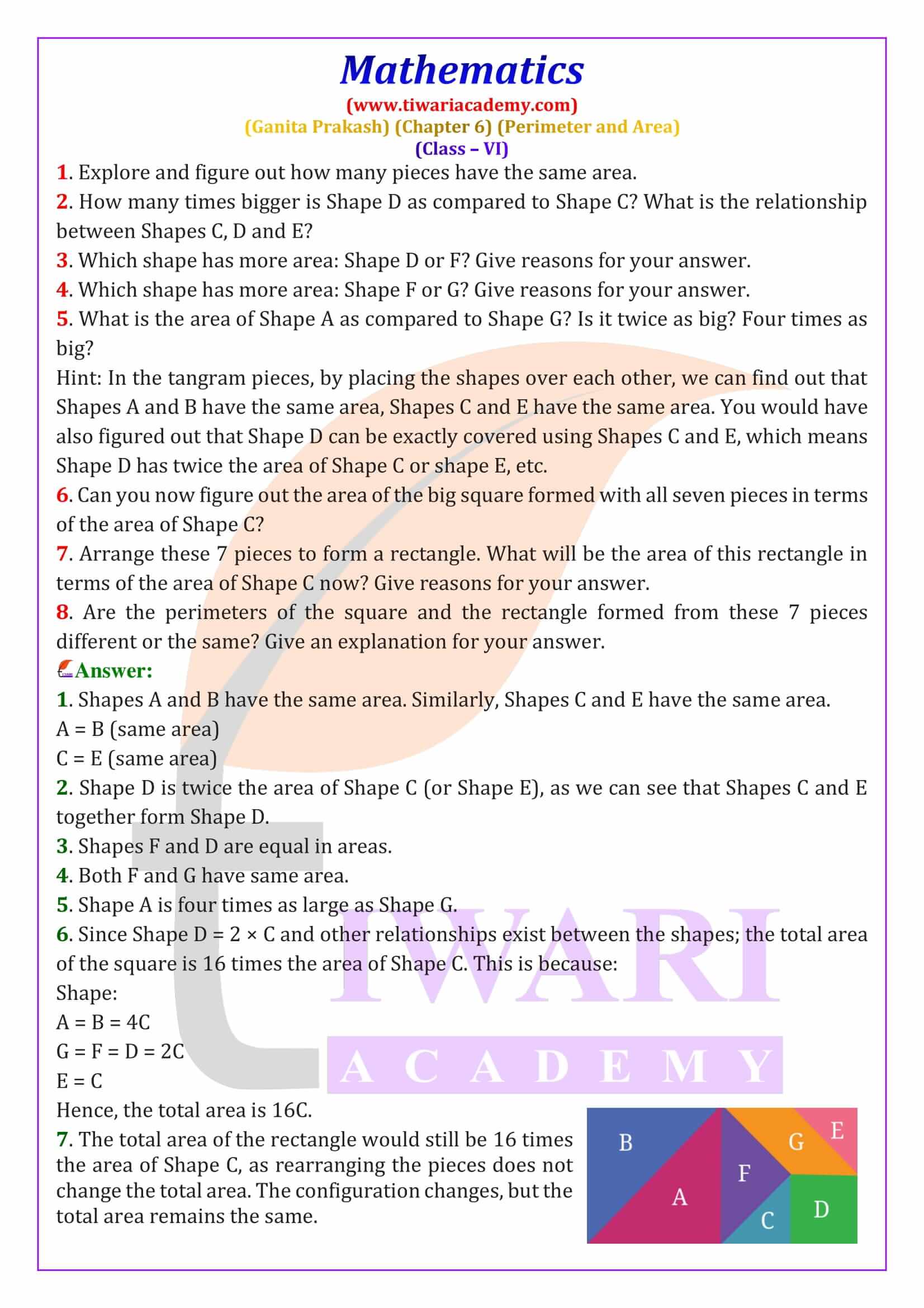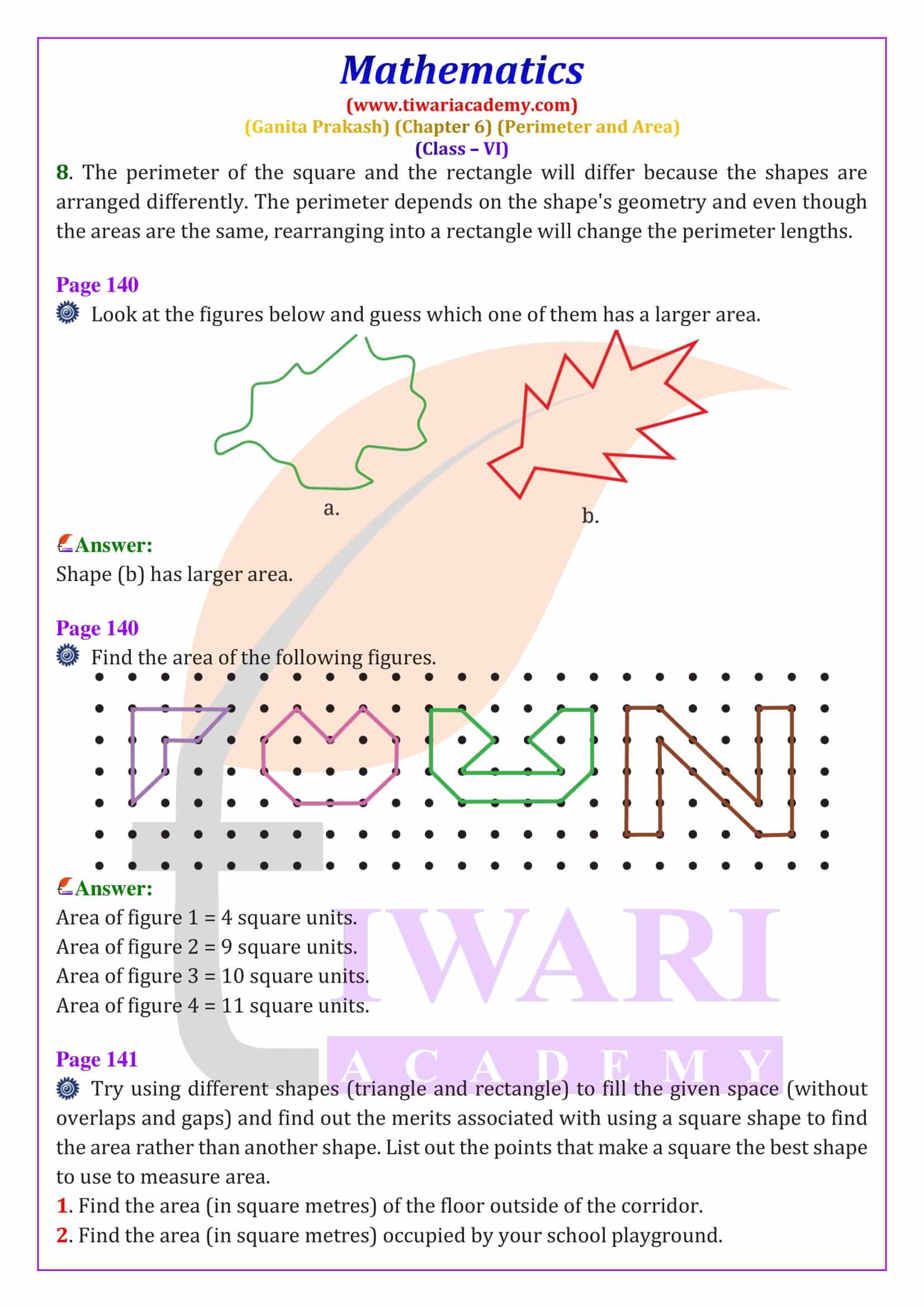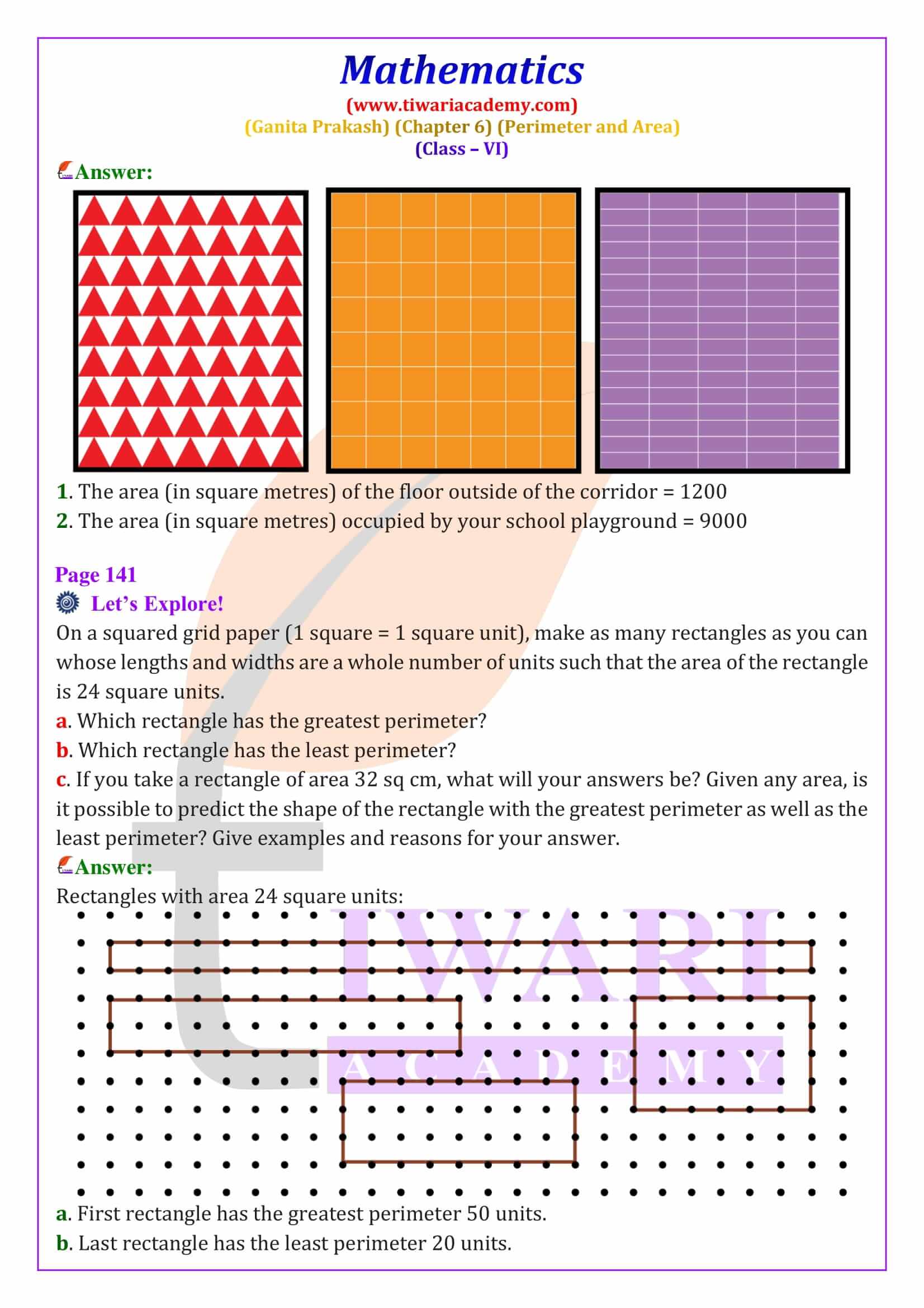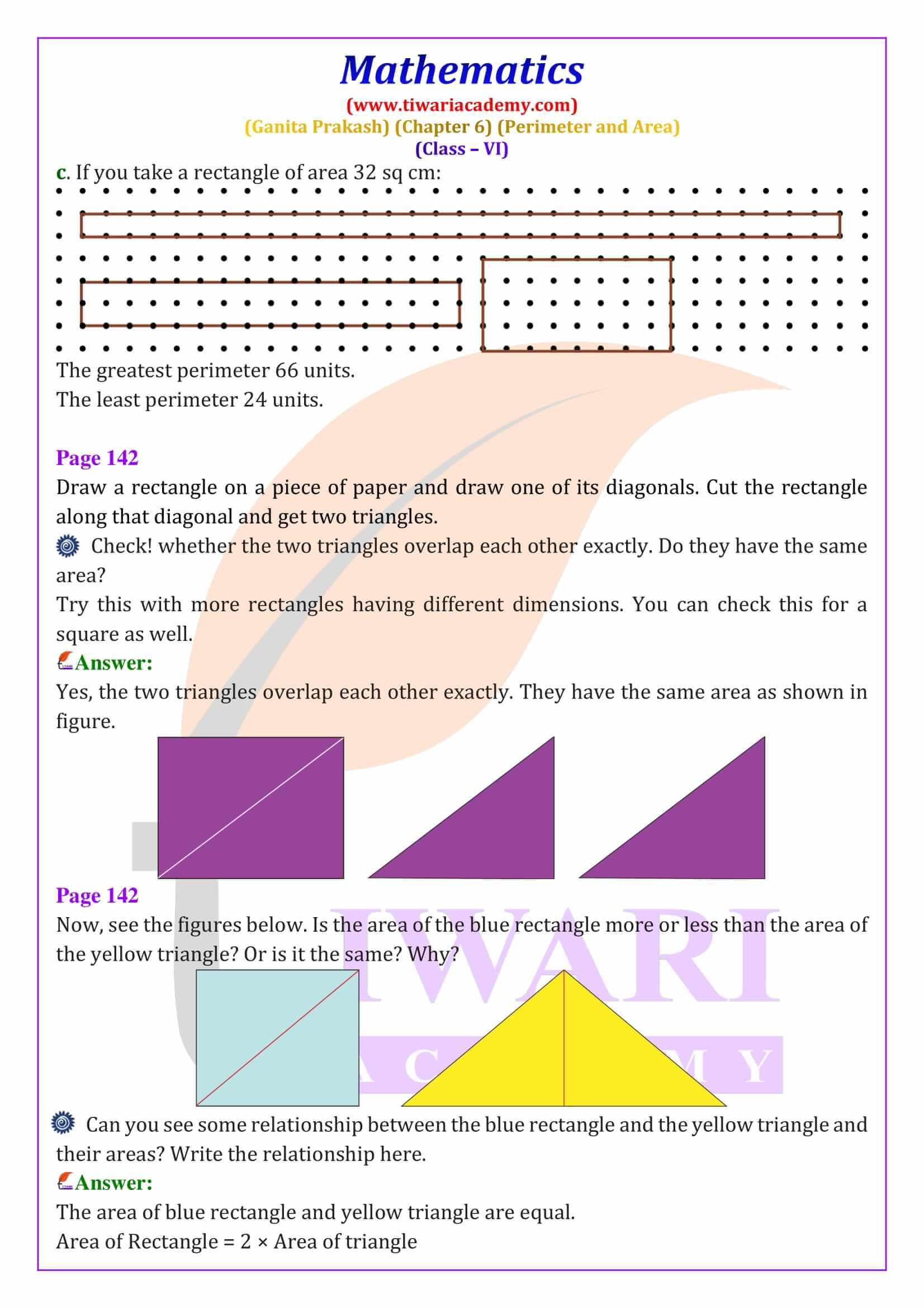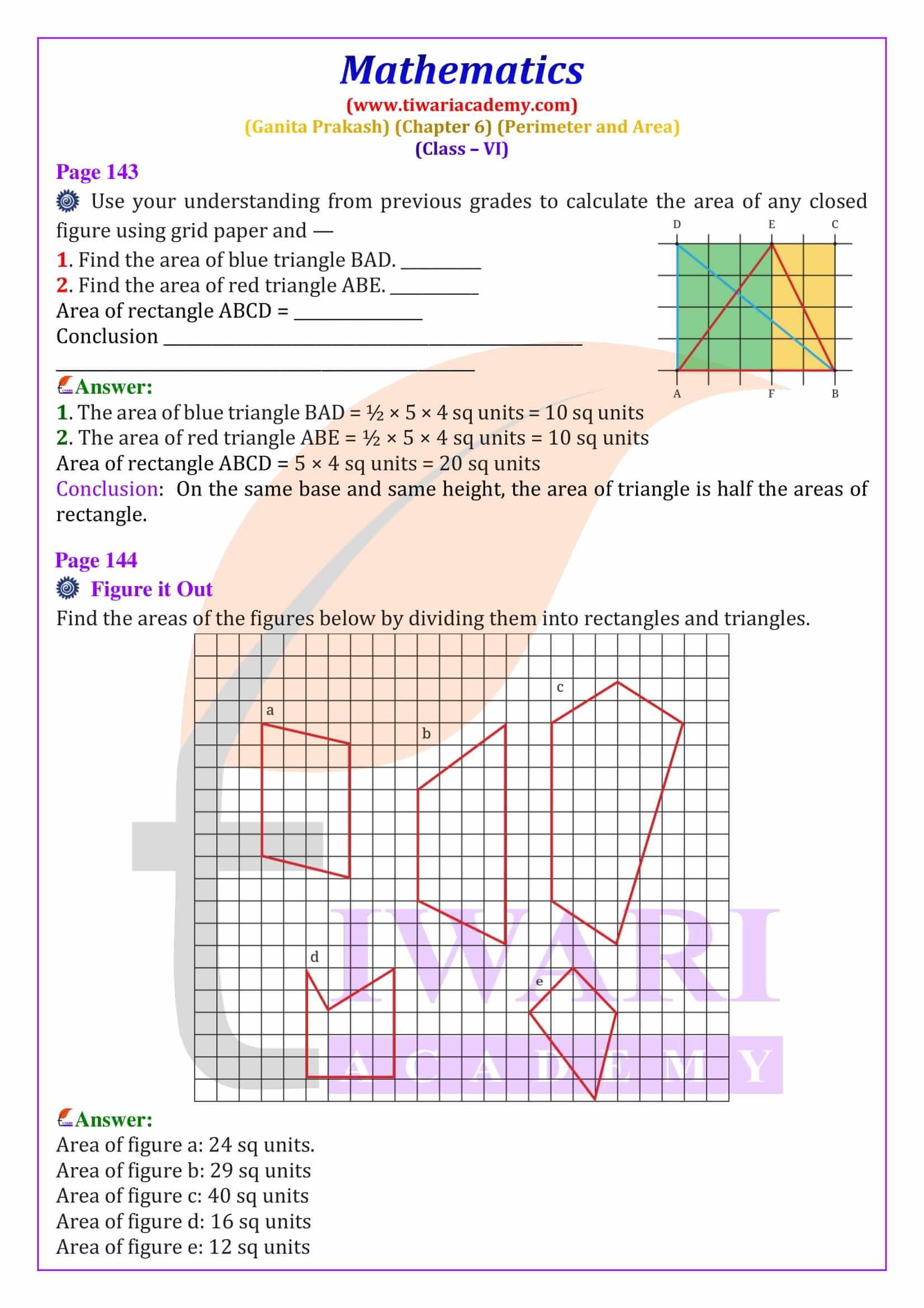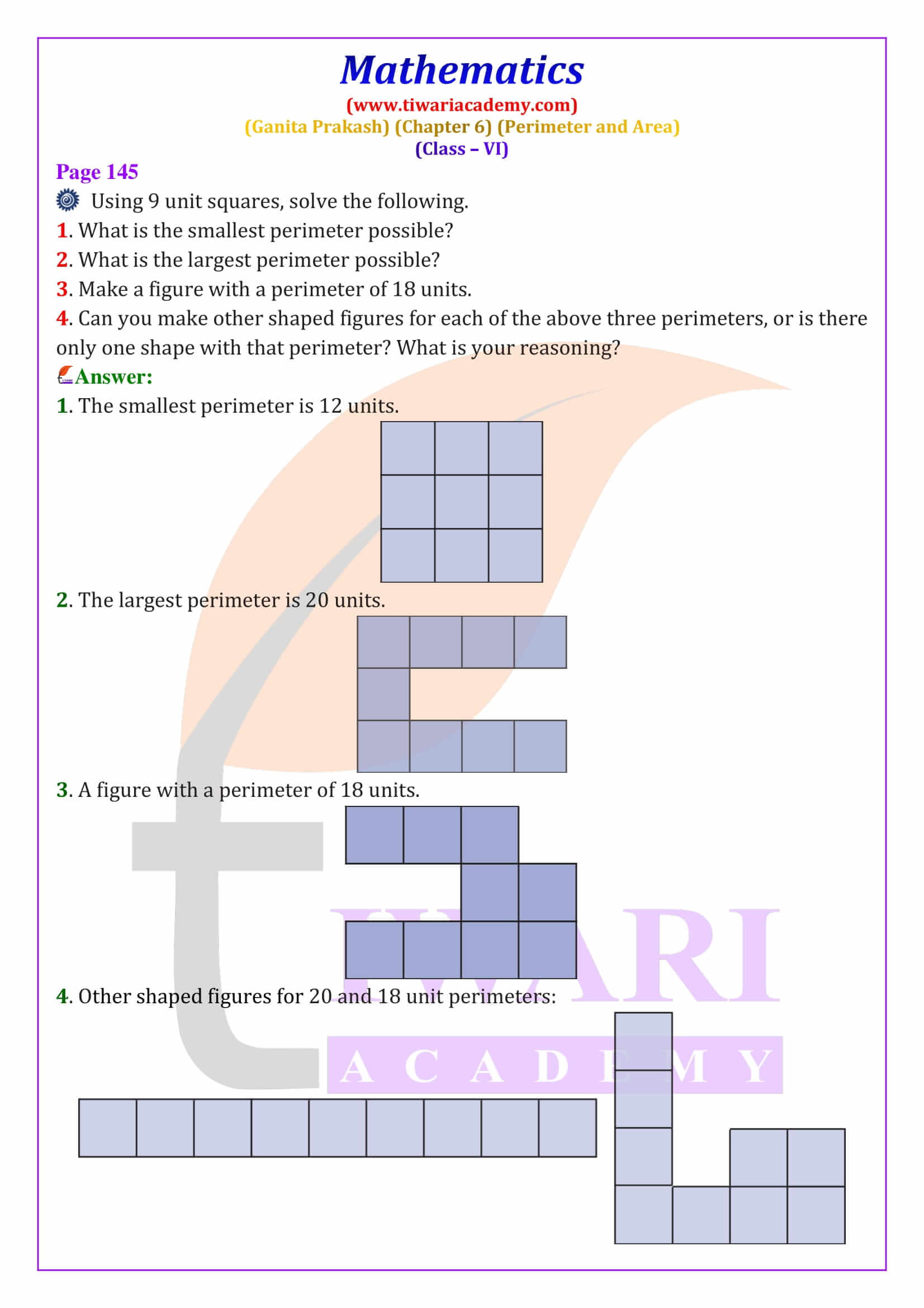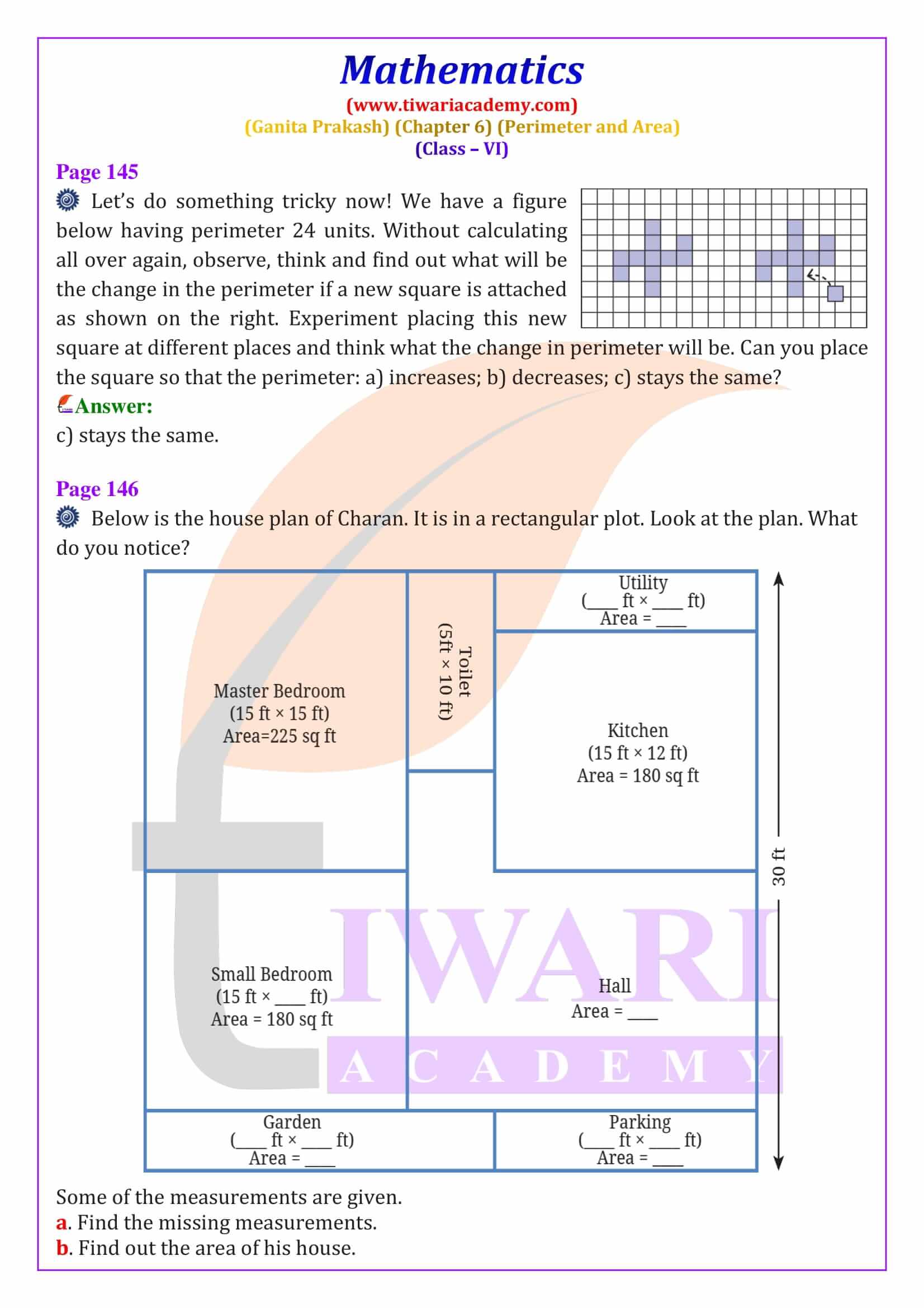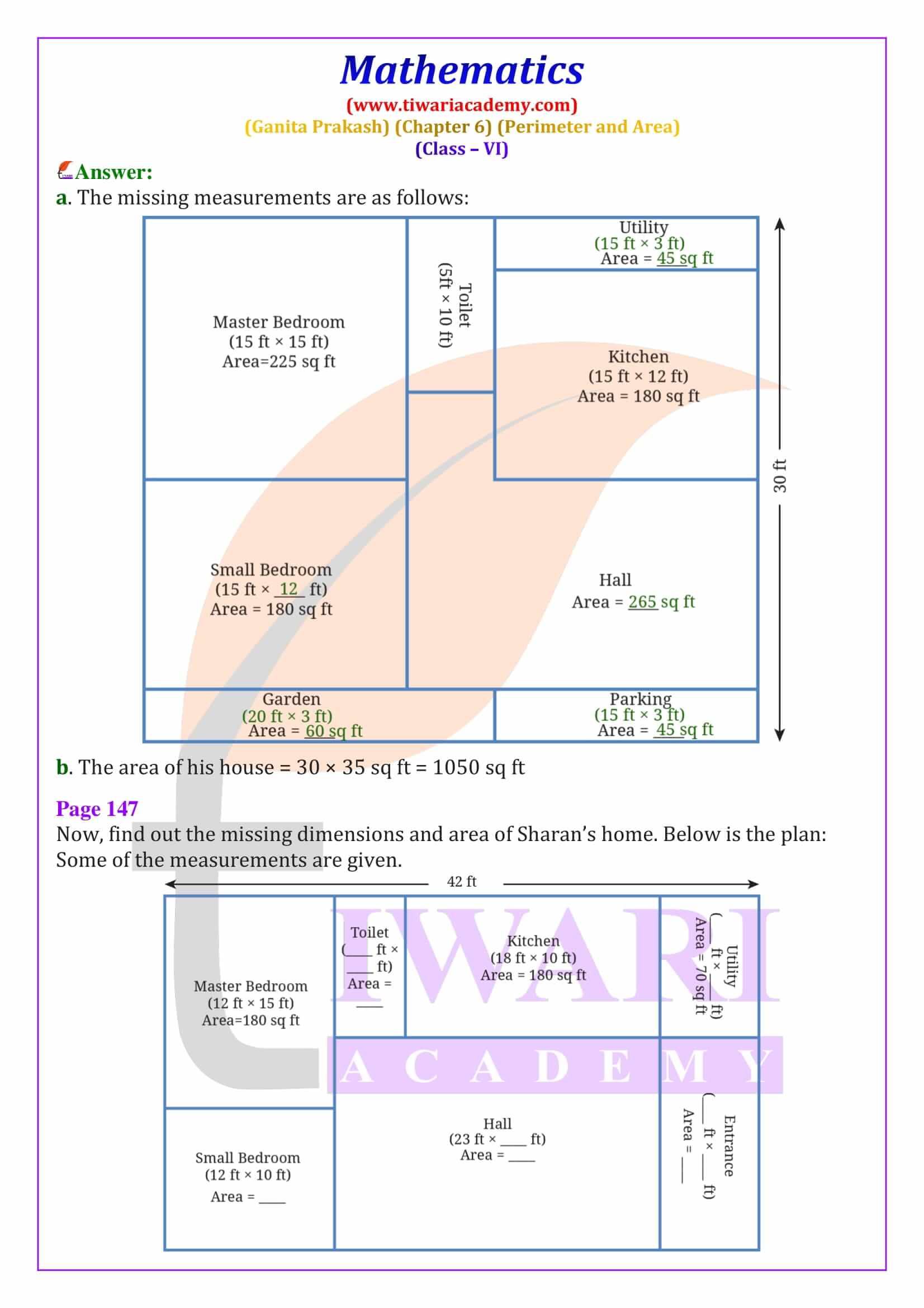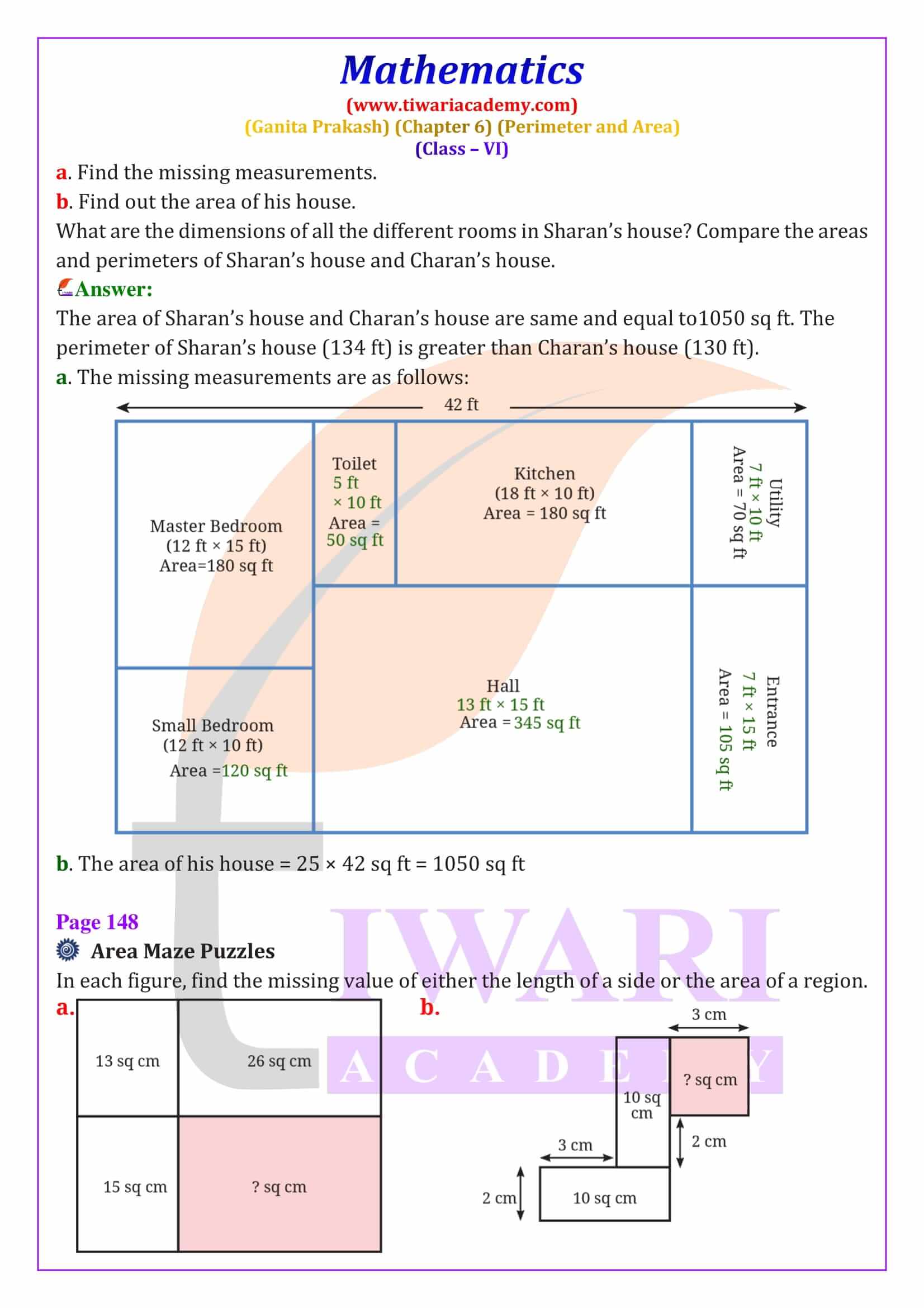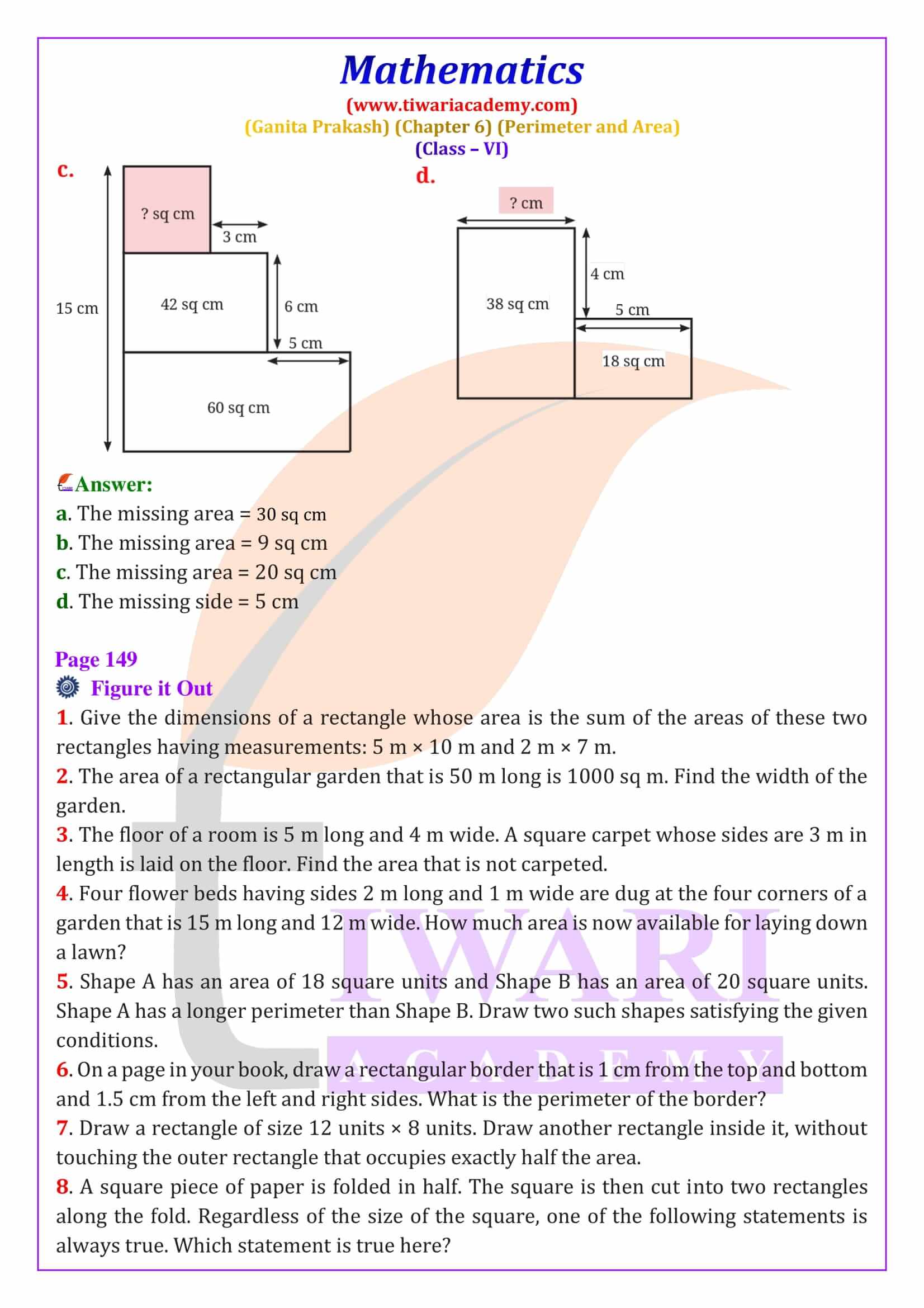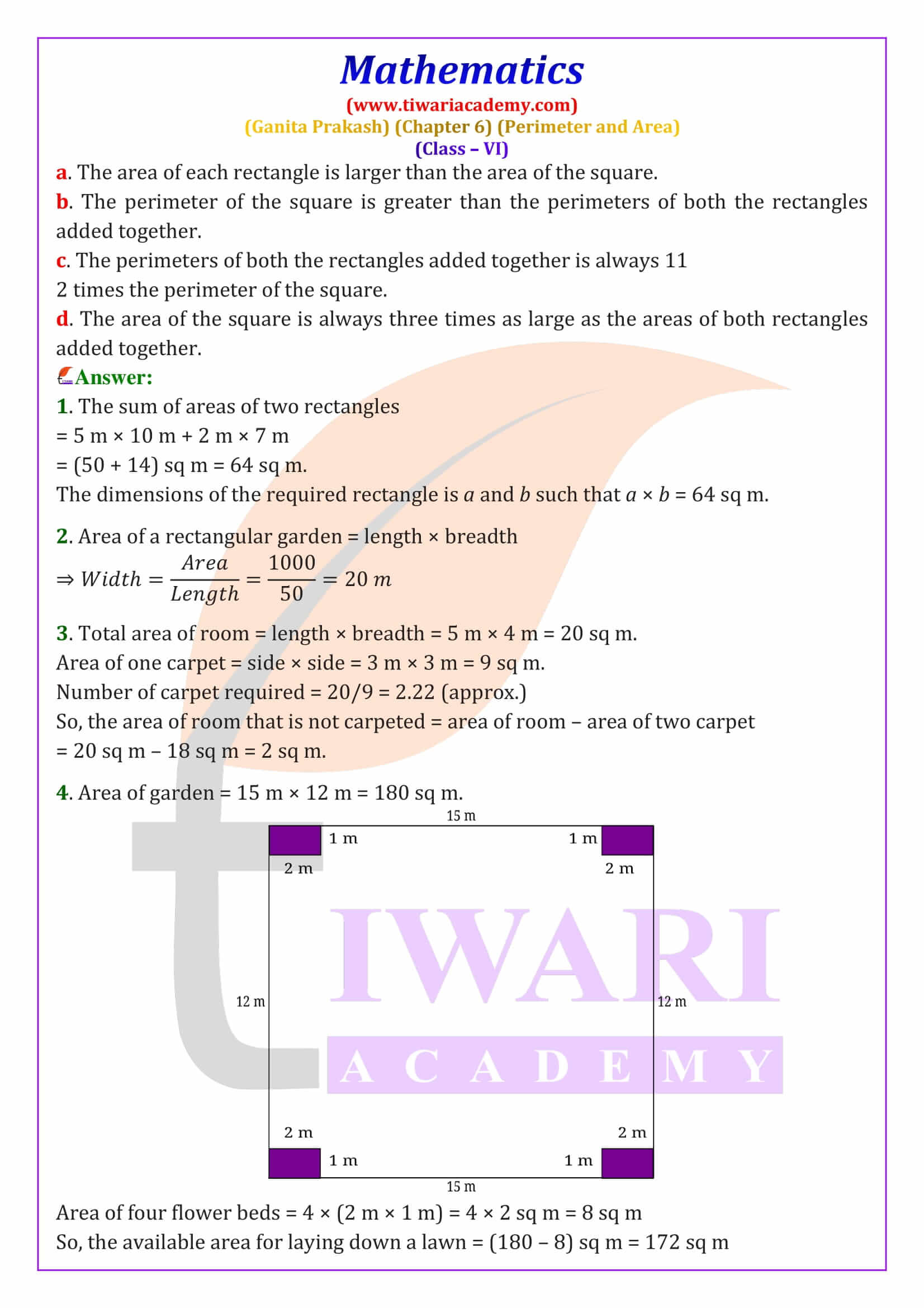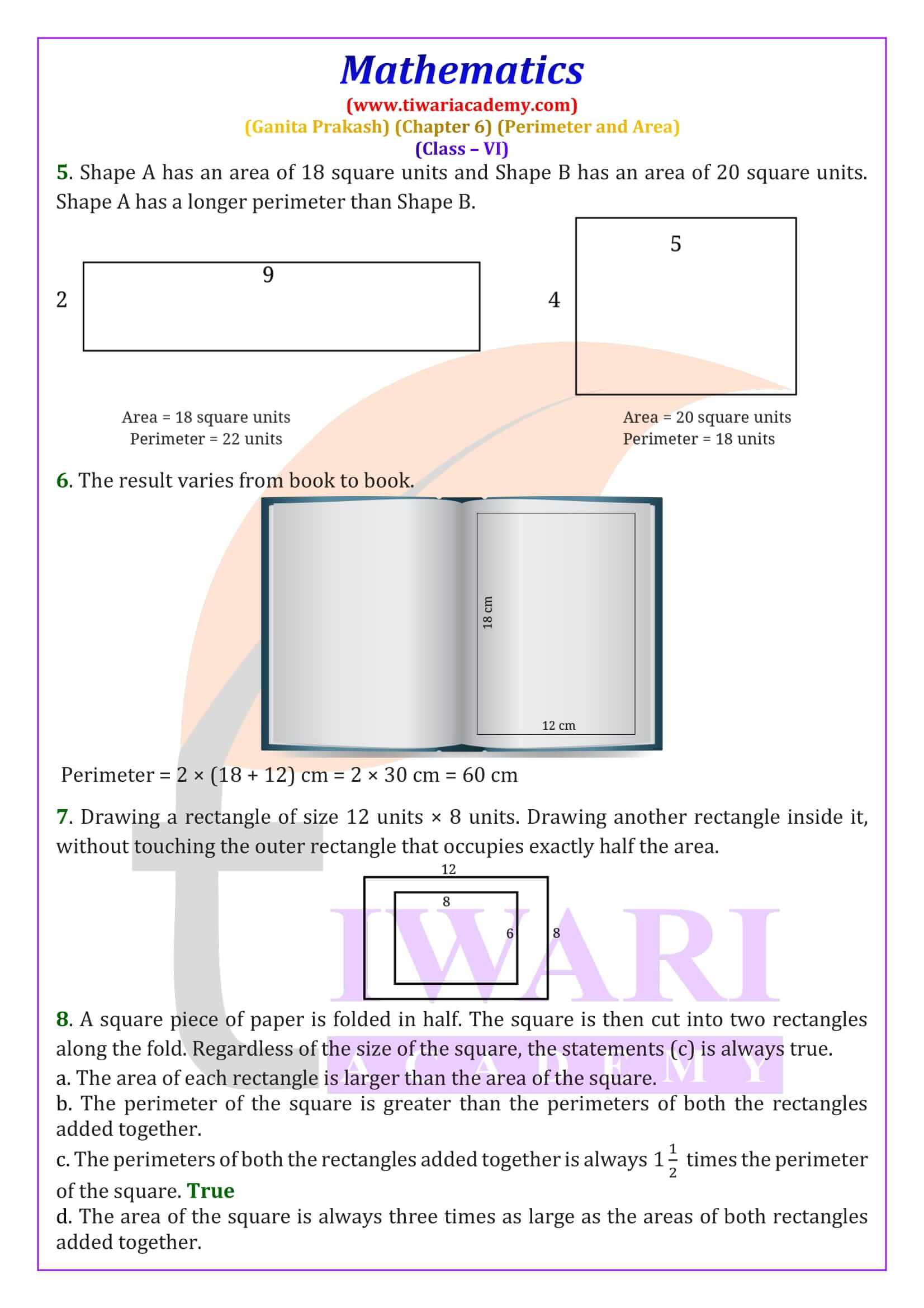NCERT Solutions for Class 6 Maths Ganita Prakash Chapter 6 Perimeter and Area updated for academic session 2025-26. Learn how to calculate the perimeter and area of various shapes with step-by-step guidance.
Class 6 Maths Ganita Prakash Chapter 6 Perimeter and Area Question Answers
Class 6 Maths Ganit Prakash Chapter 6 Perimeter and Area: An Overview
Perimeter is the distance around a closed shape. It represents the total length of the boundary. For instance, if you walk around a rectangular park, the distance you cover is the perimeter of that park. For polygons like rectangles and squares, the perimeter is the sum of all their sides. For a rectangle, we use the formula:
Perimeter = 2 × (length + breadth) And for squares, it’s simpler:
Perimeter = 4 × side
This helps in situations like fencing a garden or framing a picture.
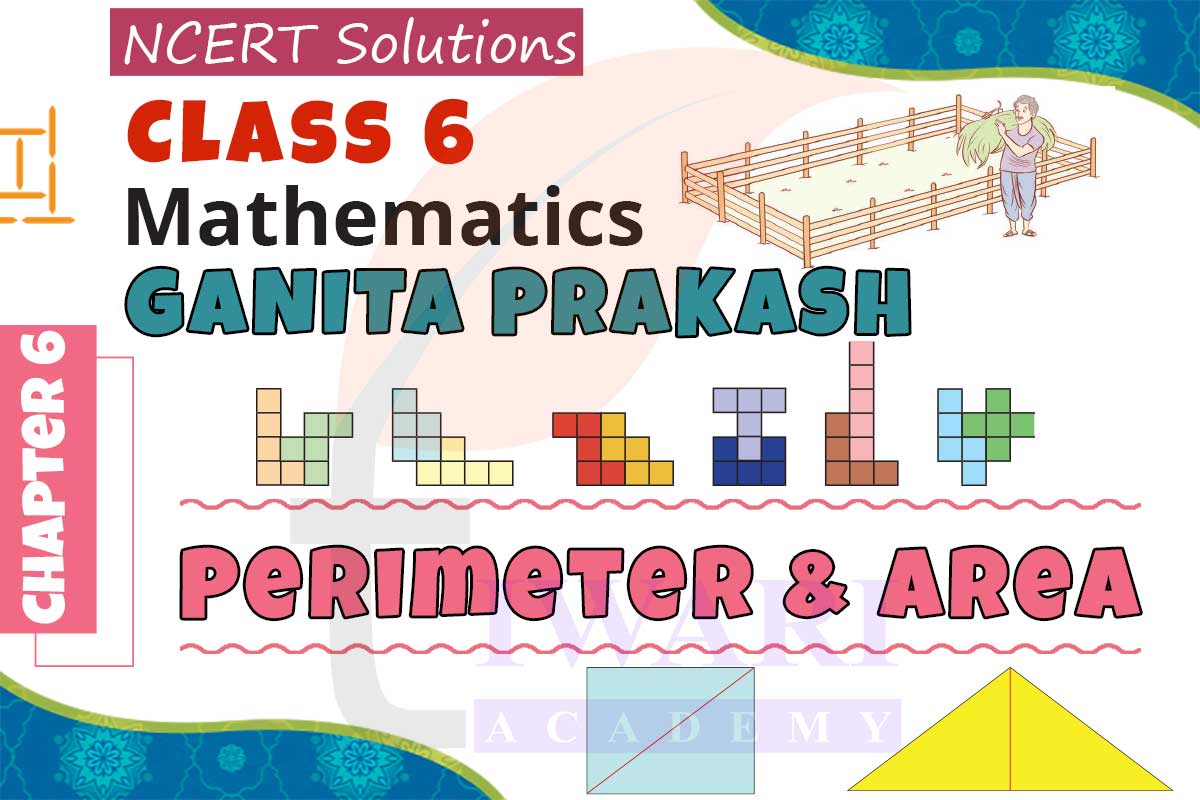
Finding the Perimeter of Different Shapes
Let’s look at examples: A rectangular tablecloth that’s 3 m long and 2 m wide has a perimeter of 2 × (3 + 2) = 10 meters. Similarly, for a square park with a side length of 75 m, the perimeter is 4 × 75 = 300 meters. Understanding how to calculate perimeters is important for many real-life situations, such as finding the length of a wire needed to enclose a garden.
The Concept of Area
While the perimeter deals with the boundary, area refers to the space inside a shape. For rectangles and squares, the area tells us how much surface they cover. The area of a rectangle is calculated as: Area = length × breadth
And for squares, the area is: Area = side × side
For example, a floor measuring 5 m by 4 m has an area of 5 × 4 = 20 square meters. This is important for tasks like laying carpets or tiles.
Area and Perimeter: Similarities and Differences
It’s crucial to understand that shapes with the same perimeter can have different areas and shapes with the same area can have different perimeters. For instance, two rectangles may have the same perimeter but different areas depending on their dimensions. This concept can help in designing spaces efficiently.
Real-Life Applications of Perimeter and Area
Consider this example: A floor is 5 m long and 4 m wide and you want to place a square carpet of side 3 m on it. The area of the floor is 20 square meters, and the area of the carpet is 3 × 3 = 9 square meters. The remaining uncovered area is 20 − 9 = 11 square meters. By understanding perimeter and area, you can make better decisions in construction, landscaping, and more.
Perimeter and Area in Regular Polygons
For regular polygons, where all sides and angles are equal, like equilateral triangles and regular pentagons, the perimeter is the sum of all sides and the area can be found using specific formulas. For an equilateral triangle, the perimeter is simply three times the length of a side and the same concept applies to other regular shapes.
Practice Makes Perfect
Understanding perimeter and area helps solve everyday problems. To get better, try solving exercises, like finding the total distance covered after multiple rounds around a rectangular track or estimating the area of irregular shapes using graph paper. For complete NCERT solutions to Chapter 6 Perimeter and Area, visit Tiwari Academy.
By practicing these concepts, students can sharpen their math skills and apply them in practical scenarios!
Is Class 6 Maths Ganit Prakash Chapter 6 Perimeter and Area difficult to understand?
Class 6 Maths Chapter 6 Perimeter and Area is not very difficult to understand if approached step by step. The chapter begins with basic concepts like perimeter, which involves adding the sides of shapes and then moves to the area, which measures the space inside a figure. These concepts are explained using simple examples of squares, rectangles and triangles, making it accessible to most students. However, for those who struggle with formulas, practicing exercises regularly will help in understanding. The key is to focus on applying the formulas correctly.
Can I prepare Class 6 Maths Chapter 6 in one day?
It is possible to prepare for Chapter 6 Perimeter and Area in one day if you are already familiar with the basic concepts. The chapter focuses on straightforward mathematical formulas and practical examples, which can be grasped quickly. Start by reviewing the definitions and formulas for perimeter and area and then solve the exercises to strengthen your understanding. However, if this is your first time encountering these topics, it is advisable to allocate more time to practice and absorb the concepts fully for better retention.
How useful is the class 6 Ganita Prakash chapter 6 for further studies?
Class 6 Maths Chapter 6 Perimeter and Area is foundational for many advanced topics in mathematics, particularly in geometry. Understanding the basic concepts of perimeter and area will help you in future classes, as these topics are expanded upon with more complex shapes and applications. For example, these concepts are crucial when learning about volume, surface area and even in real-life situations such as construction and design. Mastery of this chapter will provide a solid base for higher-level geometry and measurement in future studies.
Is Class 6 Maths Ganita Prakash Chapter 6 easy?
For students who are comfortable with basic arithmetic and geometry, Class 6 Chapter 6 Perimeter and Area can be considered easy. The formulas involved are simple and the examples given in the textbook help clarify the concepts. However, students who find it hard to memorise formulas or apply them in different contexts may find it a bit challenging. To make it easier, students should focus on understanding the logic behind the formulas and practice various problems to build confidence.
What are the main topics to know in Class 6 Maths Ganit Prakash Chapter 6?
The main topics in Chapter 6 include understanding the concept of perimeter, which is the total distance around a shape and area, which is the space enclosed within a shape. The chapter covers formulas for calculating the perimeter and area of basic shapes such as squares, rectangles and triangles. Additionally, it introduces the idea of applying these concepts to real-life problems, like calculating the amount of fencing needed for a garden or the amount of material required to cover a floor.
What are the challenging points of Class 6 Maths Ganit Prakash Chapter 6?
One of the challenges students face in Chapter 6 is memorising the different formulas for perimeter and area, especially when transitioning between shapes. For example, the perimeter formula for a square is different from that of a rectangle and students may mix these up initially.
Another challenging point is applying these formulas to real-life situations or irregular shapes, which requires a deeper understanding. Regular practice and solving a variety of problems can help overcome these difficulties, making the concepts clearer.
